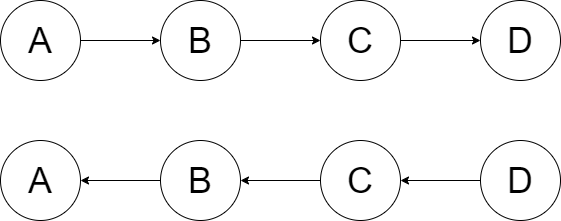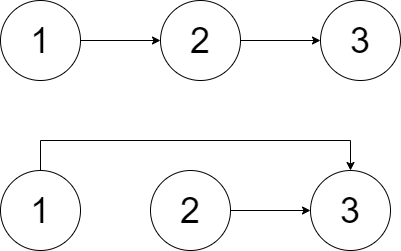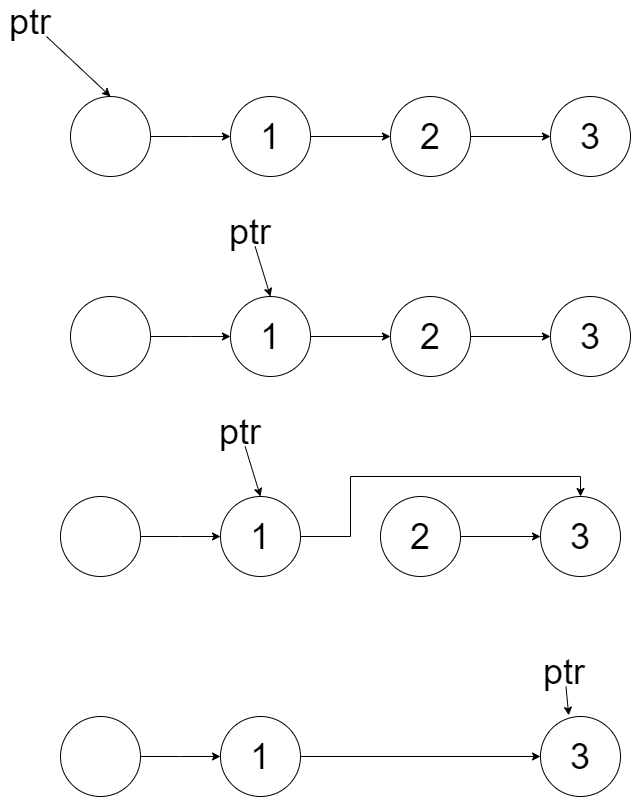今天,透過兩題Leetcode來做介紹吧![]()

單向鏈結串列是一種資料結構,其中每個節點包含一個數據元素和一個指向下一個節點的指針。這種資料結構有其獨特的優點和缺點。
現在,我們將使用C++來實現這種資料結構,並介紹如何進行一些基本操作。
首先,我們需要定義一個節點的結構,包含一個整數值以及指向下一個節點的指針。
struct ListNode {
int val;
ListNode *next;
ListNode() : val(0), next(nullptr) {}
ListNode(int x) : val(x), next(nullptr) {}
ListNode(int x, ListNode *next) : val(x), next(next) {}
};
在單向鏈結串列中,新增節點是一個基本操作,我們可以將它進一步細分為兩個部分:從頭新增和從尾端新增。
首先,我們創建一個新的節點,然後將新節點的下一個指向原始的頭節點,最後將頭節點指向新節點。
void Solution::addNode_front(int val){
ListNode *newNode = new ListNode(val);
newNode->next = head;
head = newNode;
}
我們創建一個新的節點,然後遍歷所有節點,直到找到尾節點,然後將尾節點的下一個指向新節點。
void Solution::addNode_back(int val){
ListNode *newNode = new ListNode(val);
ListNode *current = head;
if(head == nullptr){
head = newNode;
return;
}
while(current->next != nullptr){
current = current->next;
}
current->next = newNode;
}
在單向鏈結串列中,插入節點是一個常見的操作,用於在指定位置插入新節點。操作過程如下:
這樣,新節點就被成功地插入到了指定位置,並且鍊錶的連續性得到了保持。
插入節點操作允許我們在鍊錶中的任何位置插入新的數據,這在處理鍊錶時非常有用喔!
void Solution :: insertNode(int seatNumber, int val){
ListNode *newNode = new ListNode(val);
ListNode *current = head;
if(head == nullptr){
head = newNode;
return;
}
if(seatNumber == 0){
newNode->next = head;
head = newNode;
return;
}
for(int i=0; i<seatNumber-1; i++){
current = current->next;
}
newNode->next = current->next;
current->next = newNode;
}
透過leetcode來實際說明如何刪除節點吧!
難度:Easy
給定一個單向鍊錶,請反轉它並返回新的鍊錶。

通過這三個指標的協同工作,我們可以逐個節點地改變其指向,最終實現整個鍊錶的反轉拉!





這個反轉過程確保了鍊錶中每個節點的指針方向都被正確調整。這是一個在處理鍊錶的問題時非常實用且基本的技巧,它在解決各種鍊錶相關問題時都會派上用場。簡而言之,這種操作就像是把鍊錶裡的元素倒過來,非常有用!
完整程式碼:
/**
* Definition for singly-linked list.
* struct ListNode {
* int val;
* ListNode *next;
* ListNode() : val(0), next(nullptr) {}
* ListNode(int x) : val(x), next(nullptr) {}
* ListNode(int x, ListNode *next) : val(x), next(next) {}
* };
*/
class Solution {
public:
ListNode* reverseList(ListNode* head) {
ListNode *current = head;
ListNode *prev = nullptr;
ListNode *next = nullptr;
while(current != nullptr){
next = current->next;
current->next = prev;
prev = current;
current = next;
}
return prev;
}
};
透過leetcode來實際說明如何刪除節點
難度:Easy
刪除鍊錶中包含val 的所有節點,並返回新的頭。




#include <iostream>
#include <string>
using namespace std;
struct ListNode {
int val;
ListNode *next;
ListNode() : val(0), next(nullptr) {}
ListNode(int x) : val(x), next(nullptr) {}
ListNode(int x, ListNode *next) : val(x), next(next) {}
};
class Solution {
private :
ListNode *head;
public:
Solution(){
head = nullptr;
}
void addNode_front(int val);
void addNode_back(int val);
void insertNode(int seatNumber, int val);
void removeNode(int val);
void outputNode();
void Reverse();
};
void Solution::addNode_front(int val){
ListNode *newNode = new ListNode(val);
newNode->next = head;
head = newNode;
}
void Solution::addNode_back(int val){
ListNode *newNode = new ListNode(val);
ListNode *current = head;
if(head == nullptr){
head = newNode;
return;
}
while(current->next != nullptr){
current = current->next;
}
current->next = newNode;
}
void Solution::removeNode(int val){
if(head == nullptr){
cout << "list is empty" << endl;
return;
}
ListNode *node = new ListNode();
node->next = head;
ListNode *current = node;
while(current->next != nullptr){
if(current->next->val == val){
current->next = current->next->next;
break;
}
current = current->next;
}
head = node->next;
}
void Solution::outputNode(){
ListNode *current = head;
while(current != nullptr){
cout << current->val << " ";
current = current->next;
}
cout << endl;
}
void Solution :: insertNode(int seatNumber, int val){
ListNode *newNode = new ListNode(val);
ListNode *current = head;
if(head == nullptr){
head = newNode;
return;
}
if(seatNumber == 0){
newNode->next = head;
head = newNode;
return;
}
for(int i=0; i<seatNumber-1; i++){
current = current->next;
}
newNode->next = current->next;
current->next = newNode;
}
void Solution :: Reverse(){
if (head == nullptr)
return;
ListNode *current = head;
ListNode *prev = nullptr;
ListNode *next = current->next;
while ( current != nullptr){
current->next = prev;
prev = current;
current = next;
if (next != nullptr)
next = current->next;
}
head = prev;
}
int main(){
Solution data;
data.addNode_back(1);
data.addNode_back(2);
data.addNode_back(3);
data.outputNode();
data.removeNode(2);
data.outputNode();
data.addNode_front(4);
data.outputNode();
data.insertNode(0, 5);
data.outputNode();
data.Reverse();
data.outputNode();
return 0;
}
預期今天會很忙,所以凌晨先來發文~![]()
相信自己的選擇,不要因為別人認為毫無意義而氣餒。或許對別人來說無用,但只要你深信,它就對你有價值。
